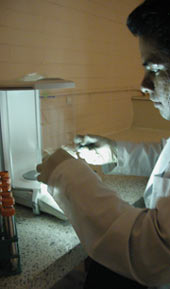A Grain a Day
“A Grain a Day” is an opportunity to shed light on the important role maize and wheat play in global nutrition and to celebrate the dietary value of these food staples. Globally, an estimated 800 million people do not get enough food to eat and more than 2 billion suffer from micronutrient deficiency, or “hidden hunger,” according to U.N. food agencies. Measures to ensure an adequate supply of vital micronutrients include: diet diversification, nutritional education, supplementation and biofortification. Scientists at the International Maize and Wheat Improvement Center (CIMMYT) are using biofortification to boost pro-vitamin A and zinc levels in maize and iron and zinc concentrations in wheat.
Recipes
You can join in the campaign by sending us your favorite wheat or maize-based recipe. All original recipes will be featured below and in our “A Grain a Day” cookbook to be published this summer.
[widgetkit id=48]
Vitamin A Orange Maize: A partnership between Agriculture and Nutrition Bears Fruit
By Yassir Islam, Guest blogger from HarvestPlus
One of the fruits of the partnership between agricultural scientists and nutritionists were the world’s first “orange” maize varieties rich in vitamin A. This ‘orange’ vitamin A maize has been conventionally bred to provide higher levels of provitamin A carotenoids, a naturally occurring plant pigment also found in many orange foods such as mangoes, carrots and pumpkins, that the body then converts into vitamin A.
Farmers in India embrace high-zinc
wheat for its nutritional benefit
By Velu GovindanUndernourishment affects some 795 million people worldwide – more than one out of every nine people do not get enough food to lead a healthy, active lifestyle, according to the U.N. Food and Agriculture Organization (FAO).
Combatting hidden hunger is key to boosting good nutrition
By Martin Kropff, CIMMYT Director GeneralThere are certain things that all human beings need to survive and food is one of them. Aside from food as a biological necessity, it is also a complex cultural product shaped by agriculture, climate, geography and the pursuit of pleasure.

“A Grain a Day” is an opportunity to shed light on the important role maize and wheat play in global nutrition and to celebrate the dietary value of these food staples. Globally, an estimated 800 million people do not get enough food to eat and more than 2 billion suffer from micronutrient deficiency, or “hidden hunger,” according to U.N. food agencies. Measures to ensure an adequate supply of vital micronutrients include: diet diversification, nutritional education, supplementation and biofortification. Scientists at the International Maize and Wheat Improvement Center (CIMMYT) are using biofortification to boost pro-vitamin A and zinc levels in maize and iron and zinc concentrations in wheat.
You can join in the campaign by sending us your favorite wheat or maize-based recipe. We’ll feature original recipes on this page and in our “A Grain a Day” cookbook to be published this summer.
Recetas
[widgetkit id=47]
Leer más:
- Link number one and we need to add a title for testing purposes
- Link number two, again for testing purposes two three four
- Link number three, finally last and title for testing four five six seven



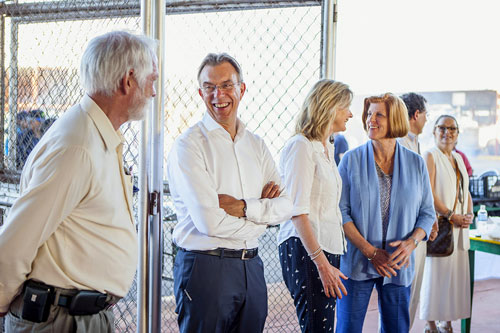
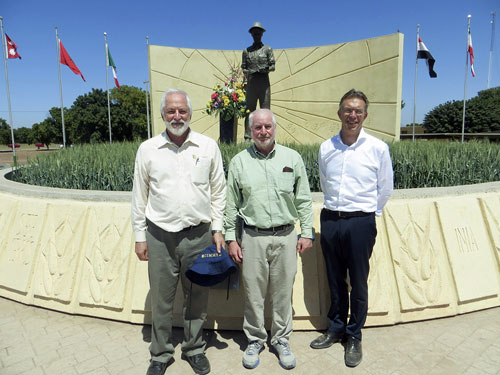

 Biofortified maize varieties have been bred to include considerably high concentrations of essential micronutrients. Maize in Asia is largely used for feed, but direct human consumption is increasing. Scientists at the 12th Asian Maize Conference highlighted several collaborative interventions to utilize the genetic variability in maize for the development of biofortified maize. Promoting biofortified maize in rural areas and developing new food products has been part of this research. The nutritional benefits of biofortified maize can come directly from eating the crop itself or indirectly by consuming eggs from hens that are fed with provitamin A ProVA-enriched maize. Biofortified maize use for feed may also represent economic benefits for farmers.
Biofortified maize varieties have been bred to include considerably high concentrations of essential micronutrients. Maize in Asia is largely used for feed, but direct human consumption is increasing. Scientists at the 12th Asian Maize Conference highlighted several collaborative interventions to utilize the genetic variability in maize for the development of biofortified maize. Promoting biofortified maize in rural areas and developing new food products has been part of this research. The nutritional benefits of biofortified maize can come directly from eating the crop itself or indirectly by consuming eggs from hens that are fed with provitamin A ProVA-enriched maize. Biofortified maize use for feed may also represent economic benefits for farmers.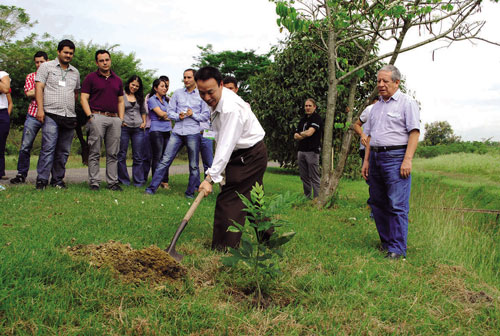



 Spot blotch is one of the major diseases in the wheat growing regions of Nepal and the knowledge allowing researchers to identify and understand the disease is thus crucial. A group of 12 wheat technical research staff from Nepal visited Banaras Hindu University (
Spot blotch is one of the major diseases in the wheat growing regions of Nepal and the knowledge allowing researchers to identify and understand the disease is thus crucial. A group of 12 wheat technical research staff from Nepal visited Banaras Hindu University (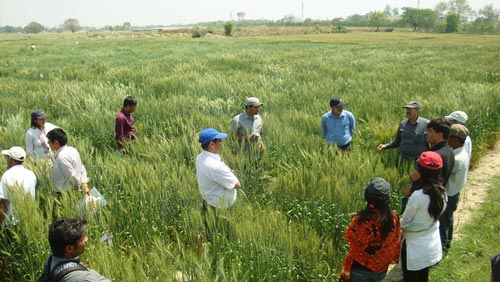 On the second day, participants visited the polyhouse and research station to learn about screening wheat genotypes
On the second day, participants visited the polyhouse and research station to learn about screening wheat genotypes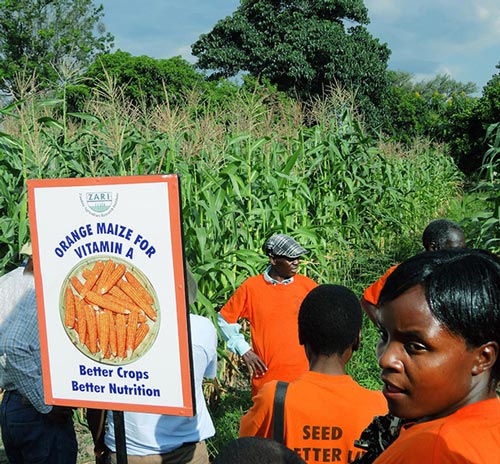 With over 50% of Zambian children under five vitamin A deficient, Zambia faces a major public health problem. This has resulted in several government intervention programs including vitamin A supplementation and sugar fortification, efforts which will soon be complemented by the release of three orange maize hybrids with higher levels of provitamin A carotenoids (compounds converted to vitamin A when consumed) developed by CIMMYT in collaboration with the Zambia Agriculture Research Institute (
With over 50% of Zambian children under five vitamin A deficient, Zambia faces a major public health problem. This has resulted in several government intervention programs including vitamin A supplementation and sugar fortification, efforts which will soon be complemented by the release of three orange maize hybrids with higher levels of provitamin A carotenoids (compounds converted to vitamin A when consumed) developed by CIMMYT in collaboration with the Zambia Agriculture Research Institute (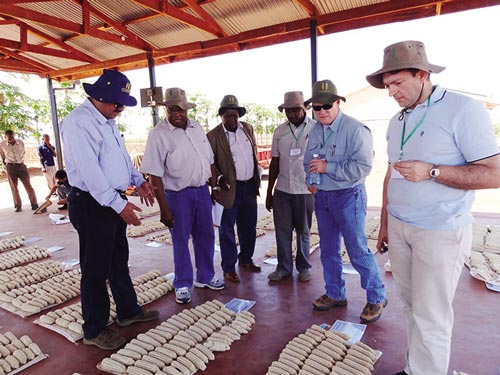 “One of the important ways to increase genetic gains and accelerate the development and deployment of improved varieties is to reduce the time needed for inbred development,” said B.M. Prasanna, CIMMYT’s Global Maize Program director. “The technology would also allow breeders to couple molecular marker-based selection for important traits such as disease resistance and quality at an early generation.” A project planning and review meeting held in Nairobi during 18-19 February 2013 was attended by representatives from national agriculture research systems, Kenya Seed Company, Seed Trade Association of Kenya, University of Hohenheim, the International Institute of Tropical Agriculture (
“One of the important ways to increase genetic gains and accelerate the development and deployment of improved varieties is to reduce the time needed for inbred development,” said B.M. Prasanna, CIMMYT’s Global Maize Program director. “The technology would also allow breeders to couple molecular marker-based selection for important traits such as disease resistance and quality at an early generation.” A project planning and review meeting held in Nairobi during 18-19 February 2013 was attended by representatives from national agriculture research systems, Kenya Seed Company, Seed Trade Association of Kenya, University of Hohenheim, the International Institute of Tropical Agriculture (
 In the continuous effort to increase awareness of wheat biofortification and its use to improve health and quality of life in eastern India, Banaras Hindu University (
In the continuous effort to increase awareness of wheat biofortification and its use to improve health and quality of life in eastern India, Banaras Hindu University (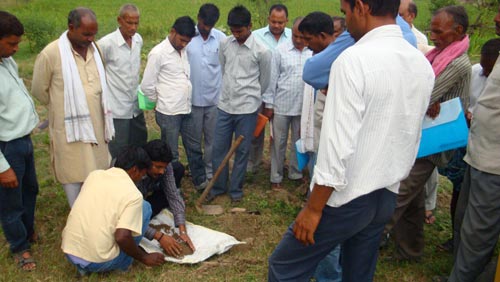 A series of farmer-scientist interaction meetings to create awareness of
A series of farmer-scientist interaction meetings to create awareness of 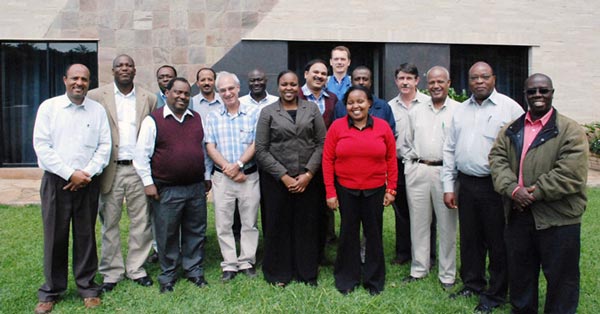
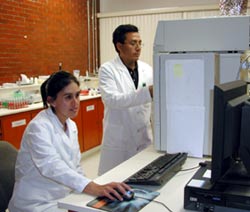 Breeding knowledge combined with cutting-edge laboratory analysis will produce maize rich in vital nutrients.
Breeding knowledge combined with cutting-edge laboratory analysis will produce maize rich in vital nutrients.